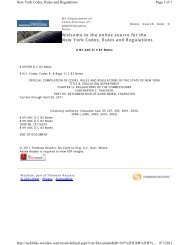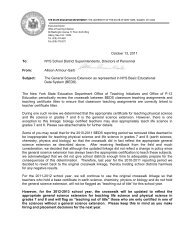ESL Learning Standards - Higher Ed - New York State Education ...
ESL Learning Standards - Higher Ed - New York State Education ...
ESL Learning Standards - Higher Ed - New York State Education ...
You also want an ePaper? Increase the reach of your titles
YUMPU automatically turns print PDFs into web optimized ePapers that Google loves.
<strong>ESL</strong><br />
2<br />
Standard<br />
2:<br />
Students will listen, speak, read, and write in English<br />
for literary response, enjoyment, and expression<br />
Performance indicators by grade level:<br />
Early Childhood (Pre-K – 1) Elementary (2 – 4)<br />
1. Read, listen to, view, and discuss literature of different<br />
genres.<br />
Such genres include picture books, fables, poems,<br />
myths, songs, and media productions.<br />
(L, S, R)<br />
1. Read, listen to, view, and discuss a variety of literature<br />
of different genres.<br />
Such genres include picture books, poems, articles and<br />
stories from children’s magazines, fables, myths and<br />
legends, songs, plays and media productions, and<br />
works of fiction and nonfiction intended for young<br />
readers, including works of American popular culture.<br />
(L, S, R)<br />
2. Use basic strategies to make literary text comprehensible<br />
and meaningful.<br />
Such strategies include previewing, reviewing, listening<br />
selectively, listening for a specific purpose, and listening<br />
for main ideas and details. (L, R)<br />
3. Recognize some features that distinguish some genres<br />
and use those features to aid comprehension.<br />
(S, R)<br />
2. Identify and use reading and listening strategies to<br />
make literary text comprehensible and meaningful.<br />
Such strategies include skimming, scanning, previewing,<br />
reviewing, listening selectively or for a specific purpose,<br />
and listening for main ideas and details. (L, R)<br />
3. Recognize some features that distinguish some genres<br />
and use those features to aid comprehension.<br />
(S, R)<br />
4. Identify key literary elements in texts and relate those<br />
features to students’ own experiences.<br />
Such elements include setting, character, plot, and point<br />
of view.<br />
(S, R)<br />
4. Locate and identify key literary elements in texts and<br />
relate those elements to those in other works and to<br />
students’ own experiences.<br />
Such elements include setting, character, plot, theme,<br />
repetition, and point of view.<br />
(S, R)<br />
5. Make predictions and inferences, and discuss the meaning<br />
of literary works to understand text presented orally<br />
and in written form.<br />
(L, S, R)<br />
5. Make predictions, inferences, and deductions, and discuss<br />
the meaning of literary works with some attention<br />
to meaning beyond the literal level, to understand and<br />
interpret text presented orally and in written form.<br />
(L, S, R)<br />
6. Develop comprehension of text to prepare to read<br />
aloud.<br />
(S, R)<br />
7. Present personal responses to published literature<br />
through words or pictures, referring to features of the<br />
text. Such features include characters, setting, plot,<br />
ideas, events, and vocabulary.<br />
(L, S, R, W)<br />
6. Read aloud with confidence, accuracy, and fluency.<br />
(S, R)<br />
7. Compose and present personal and formal responses to<br />
published literature and the work of peers, referring to<br />
details and features of text.<br />
Such features include characters, setting, plot, ideas,<br />
events, vocabulary, and text structure.<br />
(L, S, R, W)<br />
Listening (L) Speaking (S) Reading (R) Writing (W)<br />
16 <strong>Learning</strong> <strong>Standards</strong> for <strong>ESL</strong>
















